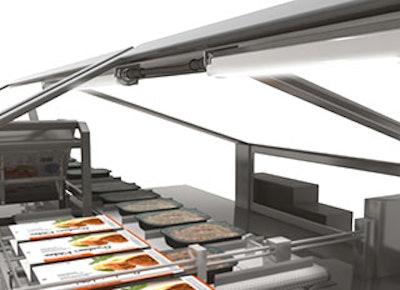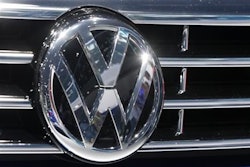
Editor's note: This article originally appeared in the November/December 2015 issue of Food Manufacturing
Lighting is crucial to any manufacturing process, but it is particularly important in food manufacturing. The main concerns surrounding lighting in a food plant revolve around safety, quality, and hygiene. LED lighting is coming on strong as the perfect choice for the consumer packaged goods industry.
Safety
Safety includes both food safety and worker safety.
In regards to worker safety, Current Good Manufacturing Practices require “adequate lighting,” which is defined by the Food and Drug Administration (FDA) in the Food Code1 as:
- 108 lux at 30” (75 cm) above the floor for walk-in refrigeration and dry storage
- 215 lux where food is provided for self service or where packaged foods are sold or offered for consumption
- 540 lux at any surface where a food employee is working with food, utensils or equipment and safety is a factor
The food safety aspect of lighting revolves around the control of foreign contaminants in food. In the aforementioned Current Good Manufacturing Practices it states that all light bulbs should be shielded, coated, or otherwise shatter resistant in areas where food is exposed. It goes on to say that even in situations where food is packaged, if the integrity of the package can be compromised by broken glass the above criteria will apply. In their review, The Physical Hazards of Foreign Materials2, the FDA sites glass as the most commonly reported foreign material responsible for illness or injury.
Shatter proof sleeves and coatings on fluorescent lights are, by far, the most common method of addressing this hazard. However, glass is only part of the hazard. According to an Interstate Mercury Education and Reduction Clearinghouse (IMERC) Fact Sheet3, the average four-foot fluorescent bulb contains 13.3 mg of mercury, an obvious environmental hazard and potential food contaminant.
LED lights can be manufactured with metal and plastic instead of glass. Additionally, LEDs contain no mercury or other health hazards.
Quality
The USDA requires that there be sufficient illumination for inspection areas in dairy, poultry, and meat plants.
As stipulated by the U.S. Department of Agriculture4 (USDA), every room where utensils for dairy products are produced, packaged or washed must have at least 30 foot-candles of light intensity on all work surfaces. Any rooms where dairy products are graded or examined for condition must have at least 50 foot-candles of light intensity on all work surfaces. Additionally, in any location where product can be contaminated, all light bulbs must be protected from breakage.
Guidelines established by the USDA5 for meat and poultry are similar; all areas where utensils are produced, packaged or washed must meet a minimum of 30 foot-candles. However, inspection stations must be either 50 or 200 foot-candles depending upon the type of inspection area.
LEDs are an excellent lighting solution for these areas. They can be built out of cleanable materials that withstand chemical cleanings and high-pressure, high-temperature washdown. Most other solutions will have to be placed in costly enclosures.
Hygiene
How can we be certain that an area has been thoroughly cleaned? Areas that are dimly lit could be missed in the cleaning process, becoming a hazard. Proper illumination allows us to observe that sanitary standards are being maintained.
Lighting is being employed in and under equipment for the purpose of maintaining hygiene. It also has the added bonus of aiding in identifying and troubleshooting any issues that may arise during manufacturing. Used in these environments, light fixtures will be regularly subjected to the harshest conditions possible, including Clean in Place (CIP) applications. It is important to select lighting accordingly for these installations; devices containing glass and poisonous metals are not advised.
Challenges
For food producers, light fixtures must be able to endure the unique challenges present in production facilities.
Temperature cycling is, by far, the greatest killer of lights and other electrical components in a washdown area. Food is often produced in a cool environment and when temperatures are raised, all of the air that is trapped in a device will expand. The opposite will occur as temperatures are restored; a device will become a vacuum, sucking in moist air, steam and even droplets on the device. Clear potting can be used to fill the cavities in an LED light, eliminating the air cavity in the product. This prevents moisture from getting into areas where there are electrical components that could short and also prevents condensation from forming on the transparent cover of the light.
Chemical exposure is a second reason that your lights could fail. It is important to use products that have seals that will stand up to chemicals used at your facility. EPDM (ethylene propylene diene monomer) seals resist common cleaning agents, including both caustics and acids.
Mechanical damage incurred during high-pressure washdown is a third issue. During washdown, water pressure may exceed 1500 psi, more than enough pressure to damage lights and other electrical components. Lights made of stainless steel are rugged and provide an easy surface to clean.
Special considerations may need to be made if your facility uses heat to treat pests, commonly referred to as “heat treat” or “thermal remediation.” Typically, AC-powered low bay lighting has an operating temperature rating of around 130° F (55° C). During thermal remediation, temperatures can elevate in excess of 140° F (60° C), straining ballasts in metal halide or fluorescent light fixtures. LED lights on a supplementary DC power circuit will withstand temperatures up to 158° F (70° C). This is a huge advantage for producers who regularly heat treat their facilities.
Calculating Cost
Beyond the simple price of an LED light fixture, there are multiple factors to be considered when comparing illumination sources and determining overall cost of a lighting solution. These include:
- Longevity – High quality LED lights will last 50,000 hours or more, which is about 5.5 years at 100% duty cycle. Fluorescent bulbs have a typical lifespan of around 20,000 hours.
- Energy Consumption – LED lights use about half of the energy of fluorescent lights and about a quarter of the energy of incandescent lights. With electricity costing an average of $ 0.125/kW hr, the savings offered by LEDs can be substantial over time.
- Maintenance – LED lights require no bulb or ballast replacements over their lifespan, resulting in significant saving in the time and labor associated with maintaining light fixtures.
- Environment – Unlike fluorescent and HID lighting, LED lights contain no mercury, an environmental hazard requiring proper handling and costly disposal fees.
- Light Distribution – A fluorescent light distributes light 360° around the bulb. Reflectors must be used to direct the light, but most reflectors in a fluorescent fixture will have < 0.7 reflectivity efficiency. LED lights are more directional and offer more usable light.
- Illumination – Because of the relatively low amounts of energy consumed, LED lighting should be compared to other light other sources based on the amount of lumens rather than wattage or size.
Conclusion
LED lighting is a safer, more cost effective solution for meeting lighting requirements in food production facilities than traditional coated fluorescent lights. When all the variables are considered, they become an appealing investment offering the added benefit of fitting into a plant’s food safety program. Unique and creative ways to package the solution continue to make them more adaptable to the challenges of the food production environment. The trend will be for more and more LED lights to be deployed into food and beverage facilities.
1Food and Drug Administration. “Food Code,” U.S. Department of Health and Human Services, 2013, Section 6-303.11
2Goldman, David P. MD, MPH, Human Health Sciences Division, Food Safety and Inspection Service, “The Physical Hazards of Foreign Materials,” Presentation for the Public Meeting on Foreign Material Contamination, September 2002
3Interstate Mercury Education and Reduction Clearinghouse, “Mercury Use in Lighting,” IMERC Fact Sheet, August 2008
4United States Department of Agriculture. “General Specifications for Dairy Plants Approved for USDA Inspection and Grading Service,” June 2012, Section 58.126(d)
5United States Department of Agriculture. “Facility Guidelines for Meat Processing Plants,” Federal Register Vol. 62 No. 164, August 1997























